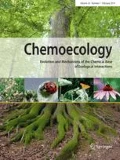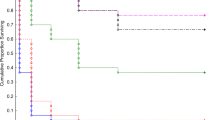Abstract
Nestling blue titsParus caeruleus L. were given diets containing homogenized ladybirds, to assess the effects of their chemical defences. The 2spot, 10spot and water ladybirds produced no apparent toxic effects when small numbers were given at regular intervals.
The pine and kidney-spot ladybirds slightly inhibit growth and may be toxic to very young nestlings. The Water ladybird is extremely distasteful to this predator, despite its lack of toxicity. The results are discussed with reference to the proposed Müllerian and Batesian mimetic relationships between the ladybird species.
Similar content being viewed by others
References
Alcock J (1970) Punishment levels and the response of white-throated sparrows (Zonotrichia albicollis) to three kinds of artificial models and mimics. Anim Beh 18:592–599
Bengston SA, Hagen R (1977) Melanism in the two-spot ladybirdAdalia bipunctata in relation to climate in western Norway. Oikos 28:16–19
Boppré M (1986) Insects pharmacophagously utilizing defensive plant chemicals (pyrrolizidine alkaloids). Naturwissenschaften 73:17–26
Brakefield PM (1984a) Ecological studies on the polymorphic ladybirdAdalia bipunctata in the Netherlands. II Population dynamics, differential timing of reproduction and thermal melanism. J Anim Ecol 53:775–790
Brakefield PM (1984b) Selection along clines in the ladybirdAdalia bipunctata in the Netherlands: A general mating advantage to melanics and its consequences. Heredity 53:37–49
Brakefield PM (1985) Polymorphic Müllerian mimicry and interactions with thermal melanism in ladybirds and a soldier beetle: a hypothesis. Bio J Linn Soc 26:243–267
Brakefield PM, Lees DR (1987) Melanism inAdalia ladybirds and declining air pollution in Birmingham. Heredity 59:273–277
Brakefield P, Willmer P (1983) The basis of thermal melanism in the ladybirdAdalia bipunctata. Differences in reflectance and thermal properties between morphs. Heredity 54:9–14
Brower LP (1984) Chemical defence in butterflies. Pp 109–134in The Biology of Butterflies. Symp R Entomol Soc (Lond) 11:109–134
Creed ER (1966) Geographic variation in the two-spot ladybird in England and Wales. Heredity 21:57–72
Creed ER (1971a) Industrial melanism in the two-spot ladybird and smoke abatement. Evolution 25:290–293
Creed ER (1971b) Melanism in the two-spot ladybirdAdalia bipunctata, in Great Britain. Pp 134–151in Creed ER (ed.) Ecological Genetics and Evolution. Oxford: Blackwell Scientific Publ
Goodale M, Sneddon I (1977) The effect of distastefulness of the model on the predation of artificial Batesian mimics. Anim Beh 25:660–665
Holloway GJ, de Jong PW, Brakefield PM, de Vos H (1991) Chemical defence in ladybird beetles (Coccinellidae). I Distribution of coccinelline and individual variation in defence in 7-spot ladybirds (Coccinella septempunctata). Chemoecology 2:7–14
Huheey J (1984) Warning coloration and mimicry. Pp 257–299in Bell WJ, Carde RJ (eds) Chemical Ecology of Insects. London, New York: Chapman and Hall
Huheey J (1988) Mathematical models of mimicry. Am Nat 131 Suppl:S22-S41
de Jong PW, Holloway GJ, Brakefield PM, de Vos H (1991) Chemical defence in ladybird beetles (Coccinellidae). II Amount of reflex fluid, the alkaloid adaline and individual variation in defence in 2-spot ladybirds (Adalia bipunctata). Chemoecology 2:15–19
Lees DR, Creed ER, Duckett JG (1973) Atmospheric pollution and industrial melanism. Heredity 30:227–232
Lusis JJ (1961) On the biological meaning of colour polymorphism of lady-beetleAdalia bipunctata L. Latv Entomol 4:3–29
Majerus MEN, Kearns P (1989) Ladybirds. Slough: Richmond Publishing
Marples NM (1990) The influence of predation on ladybird colour patterns. Ph.D. Thesis, University of Wales College of Cardiff
Marples NM, Brakefield PM, Cowie RJ (1989) Differences between the 7-spot and 2-spot ladybird beetles (Coccinellidae) in their toxic effects on a bird predator. Ecol Entomol 14:79–84
Marriner TF (1926) A hybrid coccinellid. Entomol Record 38:81–83
Marsh N, Rothschild M (1974) Aposematic and cryptic Lepidoptera tested on the mouse. J Zool Soc Lond 174:89–122
Merritt-Hawkes OA (1927) The distribution of the ladybirdAdalia bipunctata L. (Coleoptera). Entomol Mon Mag 63:262–266
Moore BP & Brown WV (1978) Precoccinelline and related alkaloids in the Australian soldier beetle,Chauliognathus pulchellus (Coleoptera: Cantharidae). Insect Biochem 8:393–395
Muhlmann H (1934) Im Modellversuch künstlich erzeugte Mimikry und ihre Bedeutung fur den ‘Nachahmer’. Z Morph Ökol 28:259–296
O'Connor RJ (1973) Growth and metabolism in some insectorivorous birds compared with granivorous species. D.Phil. Thesis, Oxford
O'Donald P, Majerus MEN (1984) Polymorphism of melanic ladybirds maintained by frequency-dependent sexual selection. Biol J Linn Soc 23:101–111
Pasteels JM, Deroe C, Tursch B, Braekman JC, Daloze D, Hootele C (1973) Distribution et activites des alcaloides defensifs des Coccinellidae. J Insect Physiol 19:1771–1784
Perrins CM (1979) British Tits. London: Collins New Naturalist
Pough FH (1988) Mimicry of vertebrates: are the rules different? Am. Nat. Supp. 131:S67-S102
Rothschild M, Moore BP, Brown WV (1984) Pyrazines as warning colour components in the monarch butterfly,Danaus plexippus, and in moths of generaZygaena andAmata (Lepidotera). Biol J Linn Soc 23:375–380
Sbordoni V, Bullini L, Scarpelli G, Forestiero S, Rampini M (1979) Mimicry in the burnet mothZygaena ephialtes: population studies and evidence of a Batesian-Müllerian situation. Ecol Entomol 4:83–93
Schmidt R (1960) Predator behaviour and the perfection of incipient mimetic resemblance. Behaviour 16:149–158
Schuler W, Roper TJ (1992) Responses to warning coloration in avian predators. Adv Study Behav 21:111–146
Timofeeff-Ressovsky NW, Svirezhev YuM (1966) Adaptation polymorphism in populations ofAdalia bipunctata L. Probl Cybern 16:161–174
Turner JR (1987) The evolutionary dynamics of Batesian and Muellerian mimicry: similarities and differences. Ecol Ent 12:81–95
Tursch B, Braekman JC, Daloze D (1976) Arthropod alkaloids. Experientia 32:401–407
Windecker W (1939)Euchelia (Hypocrita)jacobaeae L. und das Schutztrachtenproblem. Z Morph Ökol 35:84–138
Author information
Authors and Affiliations
Rights and permissions
About this article
Cite this article
Marples, N.M. Toxicity assays of ladybirds using natural predators. Chemoecology 4, 33–38 (1993). https://doi.org/10.1007/BF01245894
Issue Date:
DOI: https://doi.org/10.1007/BF01245894




